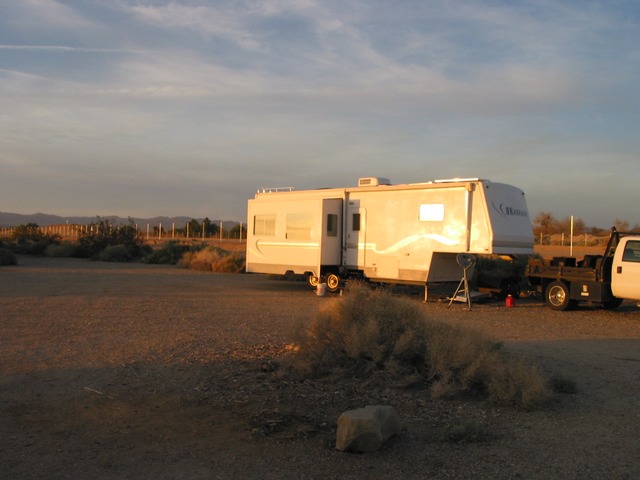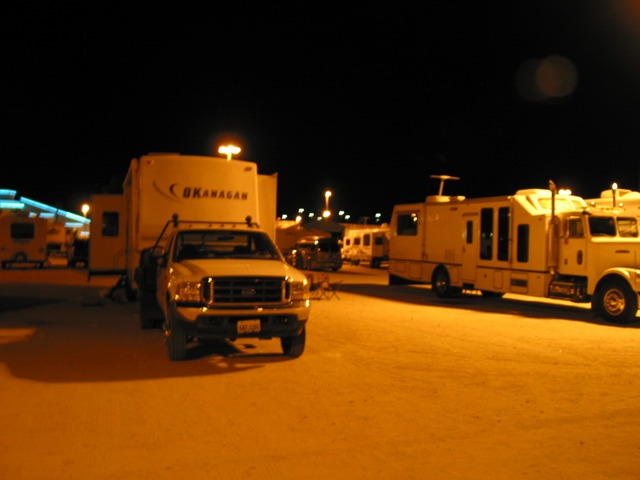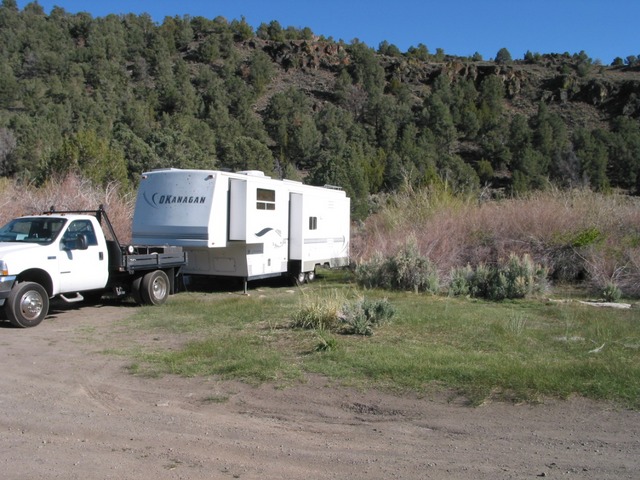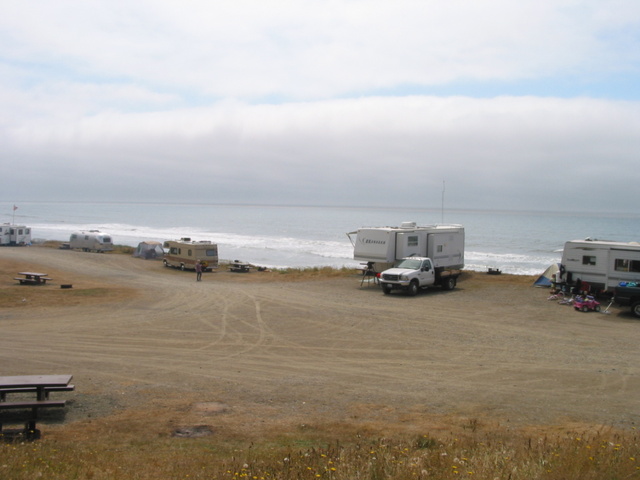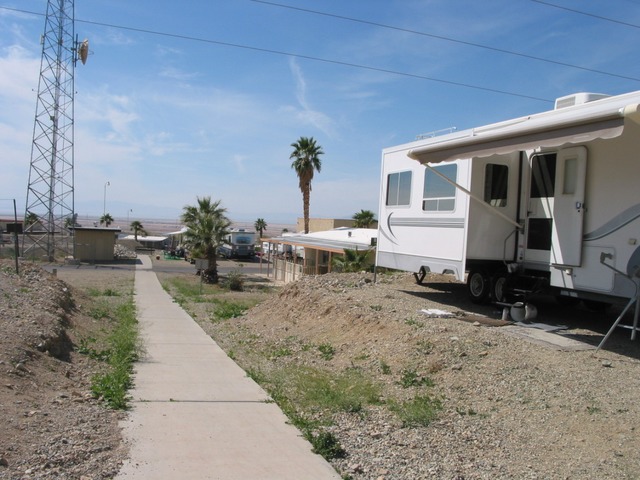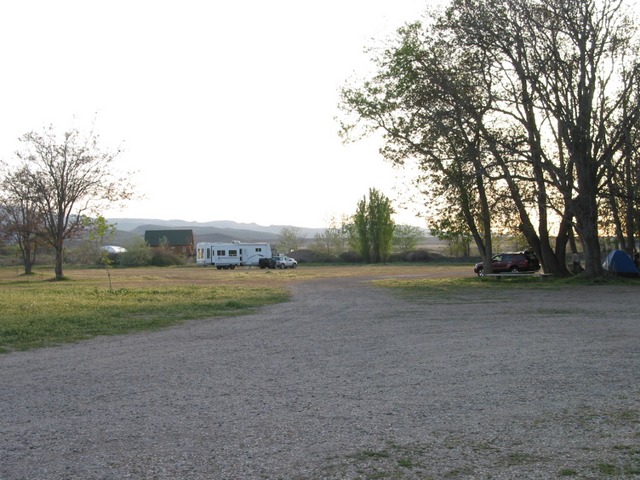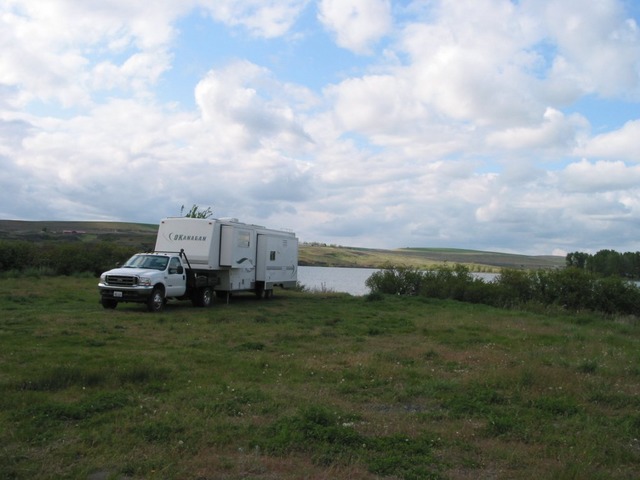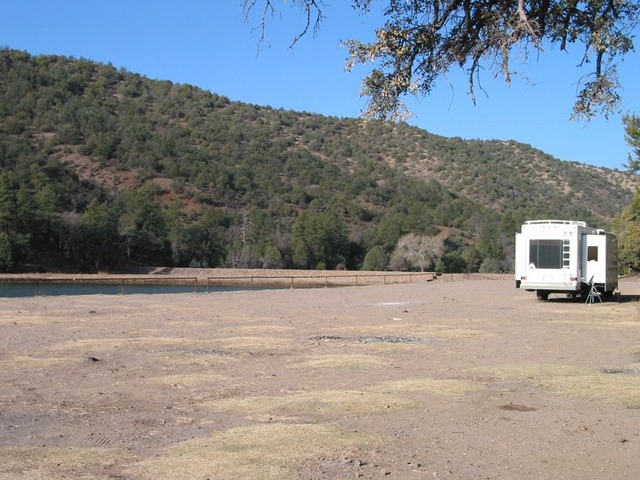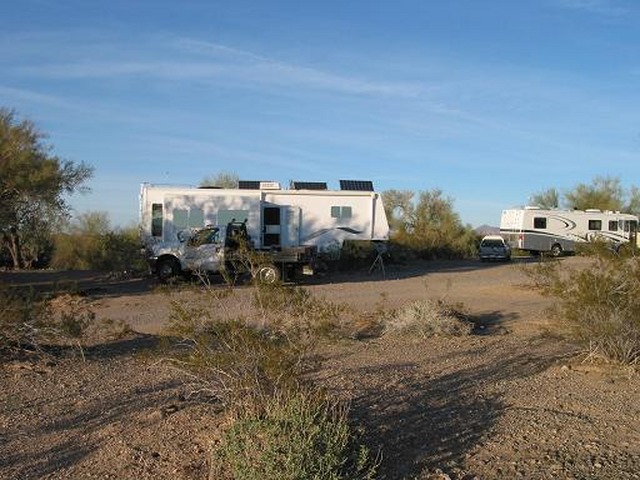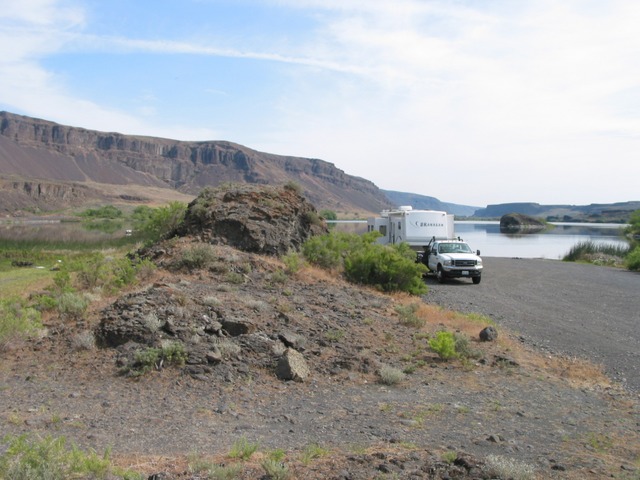
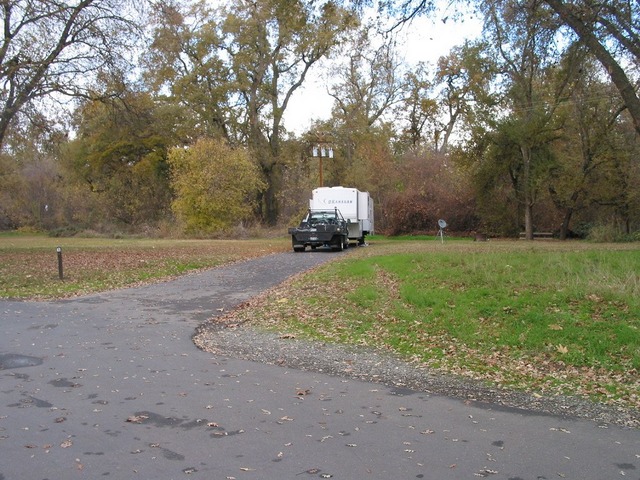

Welcome to my discussion of equipment and procedures I use when boondocking!
What is 'boondocking'? Look at these pictures.....



Pretty spots, huh? They are very nice places to be. And none of them have any hookups. Boondocking is camping without hookups - and it's great! I mean..who wouldn't want to camp there?! The first one is only 10 miles from my home in Soap Lake WA, the middle is a state park near Corning CA, and the ocean view is at South Beach camp on the coast of Washington. That place was $5 a night in 2006! Can you believe that?? Can you see why I love doing this?
Now, at an RV park...................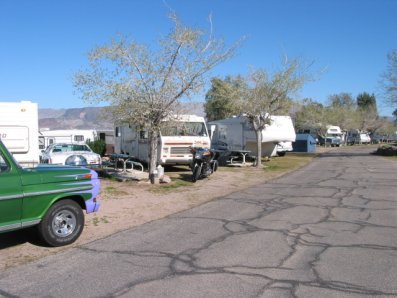
you plug in to electricity, you hook up to water and sewer and perhaps cable. When you boondock you have no such luxury, but that doesn't mean you don't have water, sewer, or electricity...you just have to work for it.
Why would anyone want to camp with no hookups?Money. Boondocking costs between $0 at fishing areas, government land and Casinos, to $20 a day in state parks. Quartzsite AZ, the RV boondock capital of the world, is about $2 a day on BLM (US Government) land. Commercial RV parks squeeze as many spaces on to their property as they can, and many charge extra for electricity. They're not interested in you if you're not coughing up at least $20 for a day's stay. I have yet to find an RV park with a boondock area, with the exception of Escapees, which by the way is a wonderful organization for RVers.
Space. Not having to be in crowded sites like the one pictured above is nice. Here's a nice spacious site. This is an old campground with plenty of room and the odors in the air are marvelous. The trees and vegetation are well-established and very pretty. Most state and national parks are like this - sites spaced farther apart.
Convenience. It's a nice feeling to know you can travel and be able to spend the night 'on the road' at a truck stop or Wal Mart. Not that a truck stop or WalMart is your ideal place for the night, but it's there if you want it. You don't have to call ahead to make reservations, you don't have to worry about being told the campground is full or pay $20 for a few hours' sleep.
Self-reliance. You're "off the grid" as they say. I carry everything with me I need to live: electricity stuff, satellite dish, cell phone with internet capability (or aircard), gasoline, extra diesel and of course, food and water. Satellite TV and wireless internet have made boondocking even more convenient and comfortable.
Knowledge of your systems. I have learned a lot about water, sewer and electricity since becoming a full-time boondocker. It's a given that you have to have more knowledge, sometimes a lot more, than one who never leaves an RV park. I think most of us already understand gallons and garbage bags, but I'll bet you could use some education in electricity. That subject scares many people out of doing what I do. I know a lot about solar, batteries, inverters and generators - the basic tools you will need to understand to have a good time instead of a worrysome time. I want you to know 'how stuff works.', but this post is just an overview of what I do, not a technical discussion.
THE BASICS OF BOONDOCKING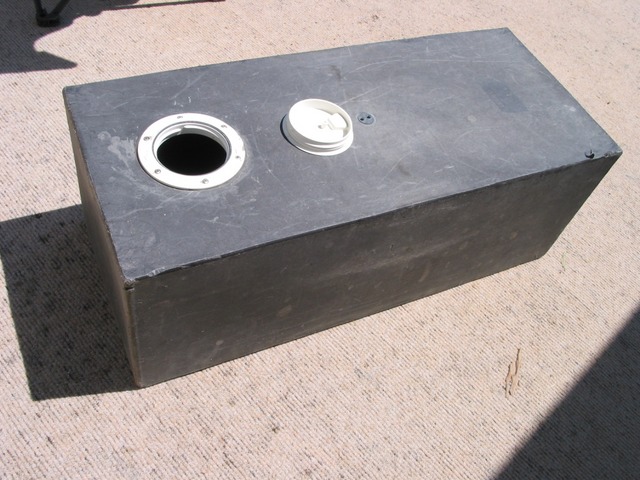
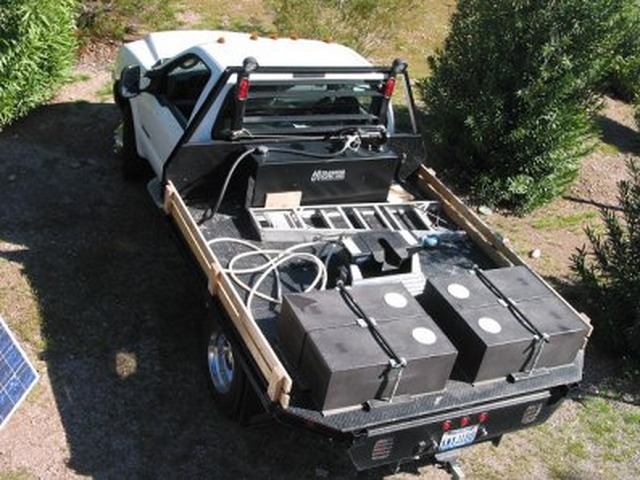
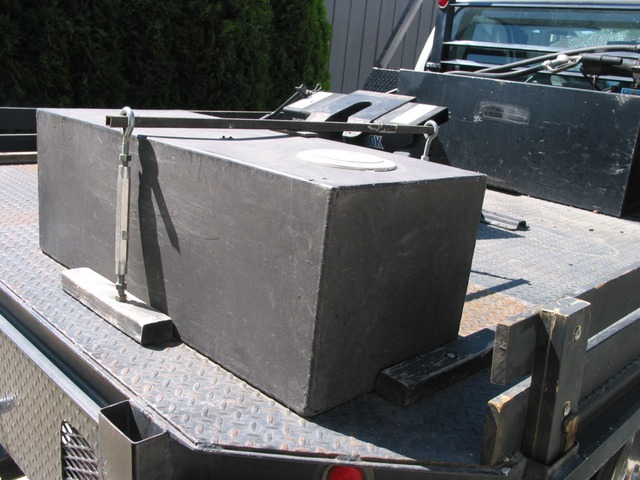
This is how I carry water to my 5th wheel. Here's a picture of how I get the water into my 5er's tank. The pump is a standard 12v RV water pump. Power comes from a small garden battery from Walmart which I connect to with alligator clips on the pump wires. I made the hoses for water intake and output. I bought the tanks from watertanks.com. They have hundreds of standard sizes, all kinds of custom fittings and will make you any size or shape you want. There are reasons I have 4 black tanks with 4" round openings mounted the way they are:
Storage. 2 of them fit nicely in my large bedroom closet, and 2 in the basement, but usually I just leave them on the truck. One or 2 larger tanks would be unwieldy, and water slosh could affect the handling of the truck. 100 gallons of water is heavy!
Algae. The tanks are black because you don't want sunlight growing nasty things in the water. Sometimes I'll go for days or weeks before using the water in the tanks. If you've ever had an aquarium you know what I'm talking about.
Cleaning. 4" openings allow for easy cleaning. When I store them, I want them dry, and it's easy to get in there with a paper towel to get all the water out.
Safe travel. The sturdy mounting brackets (my design) are for travelling. I want the tanks to be there when I get to where I'm going, and stay put when I make a hard turn! I'd rather carry heavy water on the truck than in the RV.
Your water pump may be very loud and annoying. I made some modifications to mine to solve that problem. I installed a braided household flexible line, and an 'accumulator tank' to smooth out the pulses that a water pump usually creates.
Sewer
Waste water goes into your onboard tanks. How long it takes to fill them depends on how much water you use, and how big the tanks are. I don't conserve like some people do (I like a nice shower), and as with filling the water, I cannot drive to the dump, so I have to find another way to get my waste water to the dump.
I use tote tanks, or 'blue boys' as they're sometimes called. I have a 10-gallon and a 15-gallon. Part of my daily routine is draining 10 gallons of waste water into the tank. I then pull it, by hand, using a rubber strap around the handle, to the waste dump station. 10 gallons a day is sometimes not enough, and I have to fill the bigger tank which I pull with the truck to the dump. I can fill both of them and lift the 10 gallon onto the truck bed and dump 25 gallons at once. Fortunately, I'm strong enough to lift 80 pounds. No doubt about it, boondocking is hard work!
Note the clear plastic connector on the waste pipe. That allows me to see what's in that waste water, and it helps me to know when all the water is drained from the coach. You have to be sure to close the coach's drain valve before the blue tank is full, because the sewer pipe is large and still has a lot of water in it. There's no thrill quite like having a full blue tank and a slinky sewer hose still full of poop! Arg!
I use a lot more water than most boondockers because I like the comfort, and I'm set up for it. If it were difficult for me to haul fresh water or waste water I suppose I'd use less, but I'm just not the 'roughing it' kind of guy. I don't like eating on paper plates or using plastic utensils, so I wash dishes almost every day. I take real showers, and I wash my own clothes. Here's a pic of the laundry procedure. Fill the bucket with water and soap, and go to work! I don't enjoy spending time in laundromats, but I will if I have to. By the way, I never actually sit and read in a laundromat. What's the point? Do I worry that someone will steal my clothes? Hardly. I make note of what time it is and come back in about 1/2 hour.
Electricity
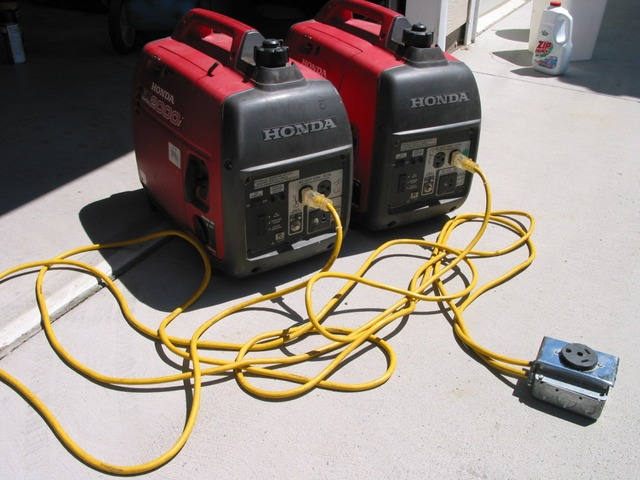
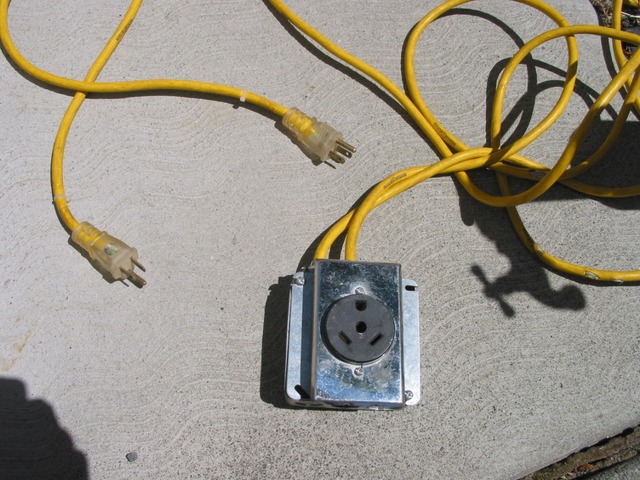
This is your main power source, your trusty generator. This is one of the best made, a Honda eu2000i. I can easily store them in the basement as they weigh only about 40 pounds. As you can see, I have two, and they can be plugged together with the adapter cables on the right to give me a whopping 4,000 watts! That's enough to run the air conditioner! I made the adapter cables myself. I plug my shore power cord into it just like you do at the RV park. If I don't need that much power, I can just use one and plug my 30a shore cord into it using a 30a-20a adapter. The Honda doesn't have a 30amp socket on it.
I don't advise getting cheap when buying a generator! I know that low price is tempting, but you really don't want one of those things you see at a Home Depot for $300. Cheap generators are NOISY. If noise doesn't bother you, it may bother your neighbors. What's nice about the Honda is, as the load decreases, like when your batteries are charging, the gen becomes quieter over time. It's called Eco mode, and it adjusts the speed of the motor to be just enough to carry the load, and no more. When it's not working very hard, it's just a quiet purr. Cheaper generators don't do that - they just run full bore all the time, and it's very annoying to be around one for too long. If you think you can't afford a good quiet generator, imagine starting up a lawn mower and leaving it just outside your rig for about 6 hours. Could you handle that?
One thought about maintenance.. don't leave gas in a generator for over a month, at least put some Sta-bil in it. When storing, drain the gas and drain the carburetor. Your owner's manual should have the procedures in it.
Batteries, $80 or more eachMy batteries are called flooded batteries, because the lead plates are covered with water. I used to have to remove the white caps (shown in the above linked picture), and check the water at least every month, but, I've upgraded to these:
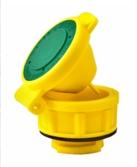 | These caps 'rain' water back into the battery cells, so you rarely have to add water. At $4 apiece they aren't cheap, but really keep the maintenance to a minimum. They are available at Arizona wind and sun |
If you're staying overnight at WalMart, you don't want to be running a generator which attracts attention - unwanted attention. Small generators are easily stolen, and I don't trust the late-night Walmart crowd to even KNOW I have a generator. With an inverter you don't have to fire up a generator to heat something in the microwave. You can have house power all the time from your batteries. I did the installation myself.
You can pay less for an inverter, much less, but I like good products that perform well, and I wanted to be able to run everything in my coach. Yes, it will even run the air, but I never do that for very long. I hooked it up "whole house", which means it's just like plugging into shore power or to a generator. My Prosine, because it's installed the way it is, also serves as a power minder, like a surge protector. It will not allow 'bad' power into my coach. The control panel shows me the state of charge (volts) of my battery bank and my current amperage draw. I will provide a more detailed description in another page soon.
 | Prosine panel tells me my state of charge. I can set many parameters of my system, including battery bank size, type of battery, and when to shut down shore power if it gets too low or high. My inverter is a great power minder!! |
Solar panels, about $350 each, Controller, $250
Flat on roof_______________________________tilted
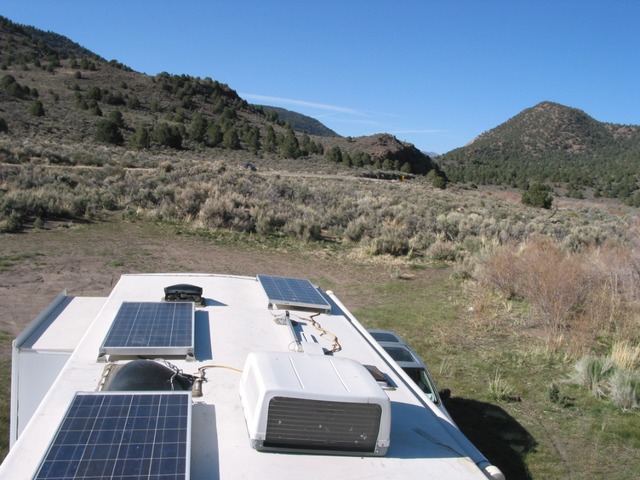
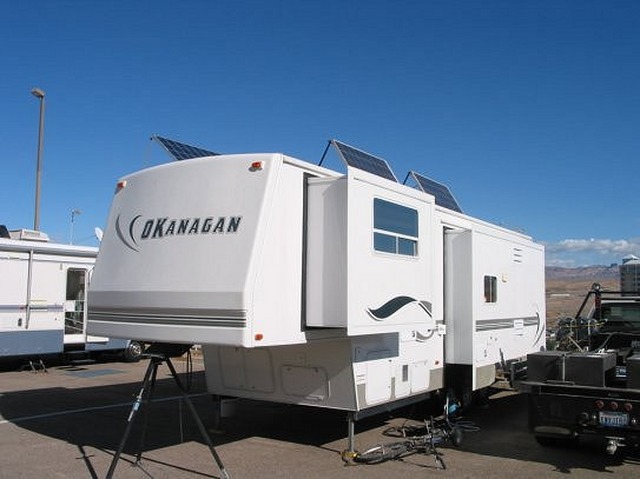

You should not hook panels directly to your batteries. I've seen it done by some old timers who don't know any better, but, they don't know any better. The panels put out about 18 volts without a controller, and that's way too much for your batteries. You need a controller (black box shown below) which not only brings the voltage down to a safe level, but also boosts the amp output. The controller is your "real" battery charger. See the "13.8" in the display? That means the batteries are getting 13.8 amps of charge.
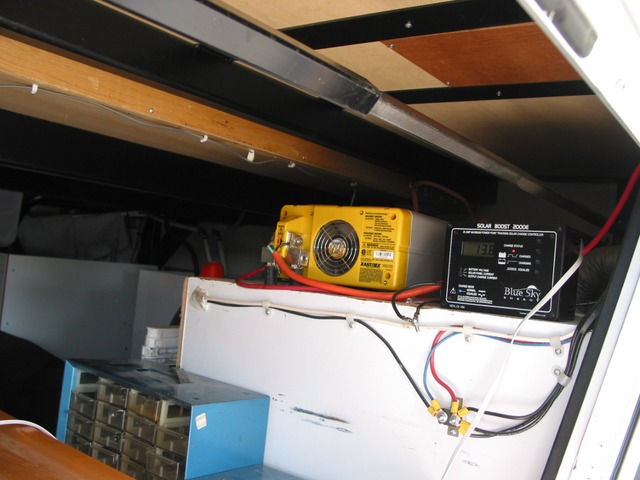 | The solar controller's output wire (the larger orange one coming out the left side of the controller) is connected to the 12v terminals of the inverter, which are in turn connected to the batteries. That charges the batteries, as does the inverter/charger. (The batteries are underneath the controller and inverter.) The systems don't conflict with each other at all because, electrically, it's just like hooking the controller directly to the batteries! |
People often ask "What can you run with solar panels?" They may be thinking a panel is hooked directly to something. It isn't. Solar panels have one duty: charging batteries. As for what they will "run", think of it like this: Let's say I have my television, sat receiver and computer running. Those appliances draw about 12 amps from my batteries (thru the inverter.) If at the same time my solar panels are outputting 12amps to my batteries, then my solar panels could be said to be "running" things. How's that?
Communications and entertainment
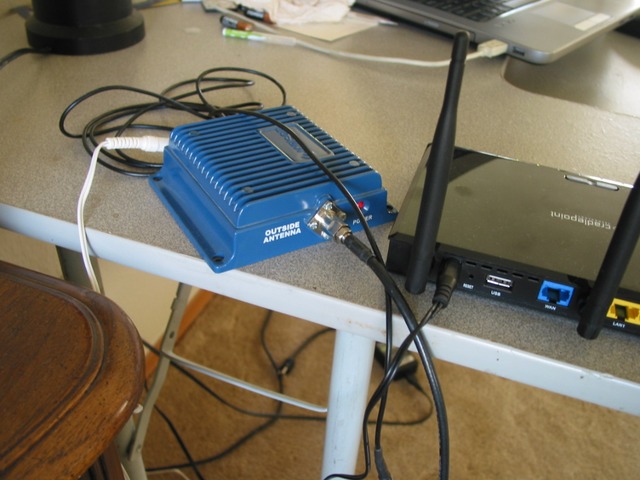
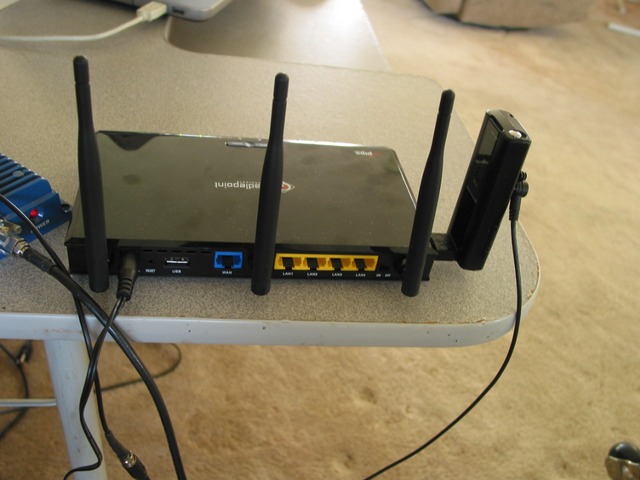
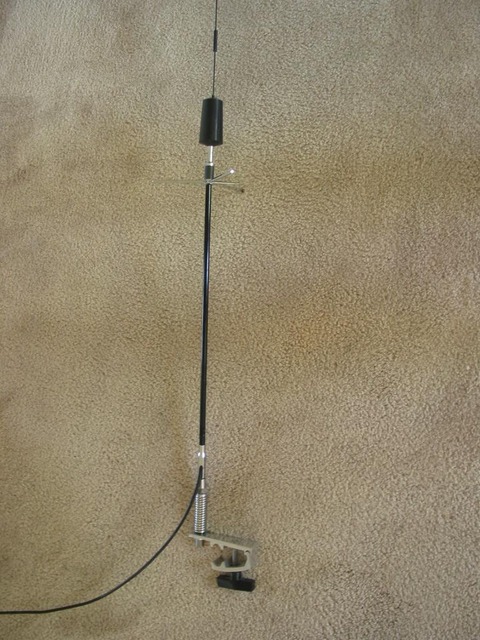
Wifi
Wifi is wireless high speed internet...in theory. I have a Sony laptop with a Linksys USB wireless adapter connected to it. I won't go into details here - it can be a long subject! Whenever I need to work with pictures on my hosting site I much prefer the wifi connection, but my Verizon USB150 Aircard often gets a very fast connection too!
Many RV parks offer the service, either free or for a fee, but it's often weak and slow. You can also find free signals in many towns or residential neighborhoods. I spent a night in my rig at a tow company's parking lot in Baker City OR, and was pleasantly surprised to find a wifi signal right from the coach! That was before I had cellular internet, so I was very happy.
I was camped near Sequoia National Park where I found an open wifi signal outside a dentist's office in a small town. Wifi is where you find it! I don't advocate 'stealing' a signal for long periods of time or on a regular basis, but for that occasional need, I have no problem with it. And I'm not paranoid about someone hacking my system by providing a wifi signal like fishing with bait. It just seems implausible me.
Reference books




I can save locations while driving too. If I happen to pass a nice spot, I can go through these steps and save that location for future reference (not that I can rename it at that time, however). Oh.. ever forget where you parked in a casino lot? I have, but I never do if I 'mark the spot' with my GPS before leaving the car.
Your GPS may take a bit of practice to understand all it can do for you. GPS units are not perfect... they have been known to direct people on roads that don't exist or routes that are longer than necessary. You still may need paper maps and your own good judgement, because GPS can always get you close to something, just not exactly there. Many perfectly good units get returned to stores, not because they don't work, but because buyers are confused by them and expect perfection. Don't expect a real user-friendly unit for cheap either. Spend some time with your unit. Use it in a place you're familiar with and try out its various features. Experiment with POIs -Point of Interest like stores, gas stations etc. Key in addresses, intersections, and whatever else your unit will accept. See if you can use coordinates and elevation, see how it works as a compass and speedometer! Hey.. these units can do a lot!GPS is just another tool, it will only work as well as you expect it and can operate it. Be patient with it, work with it, and if all else fails.. RTFM!! If you don't know what that means, I'm sure google can help you!
PHOTO ALBUM
Thanks for taking the time to read this. Click here to view all the pictures in this document (and more!) in my photo album.
